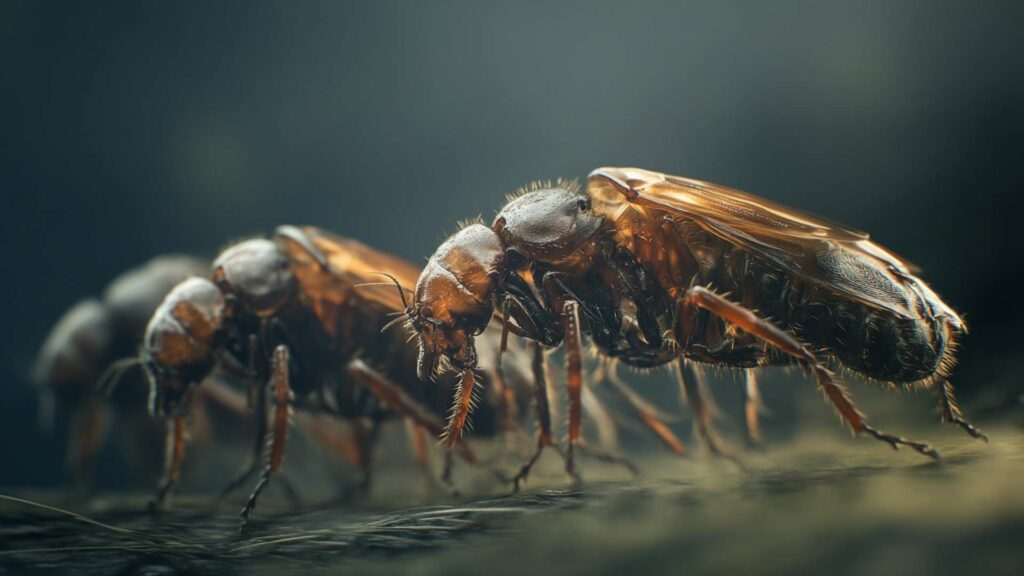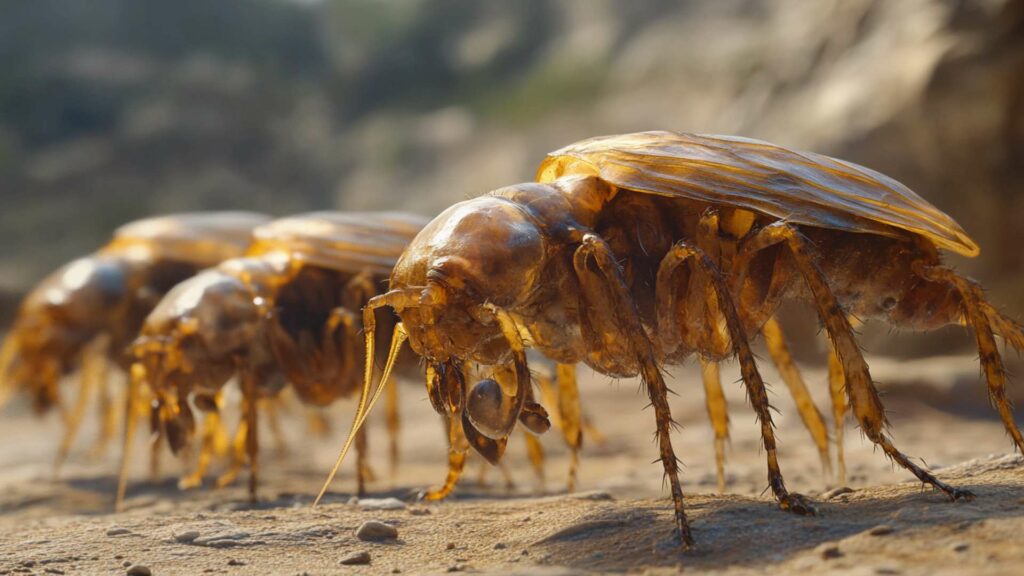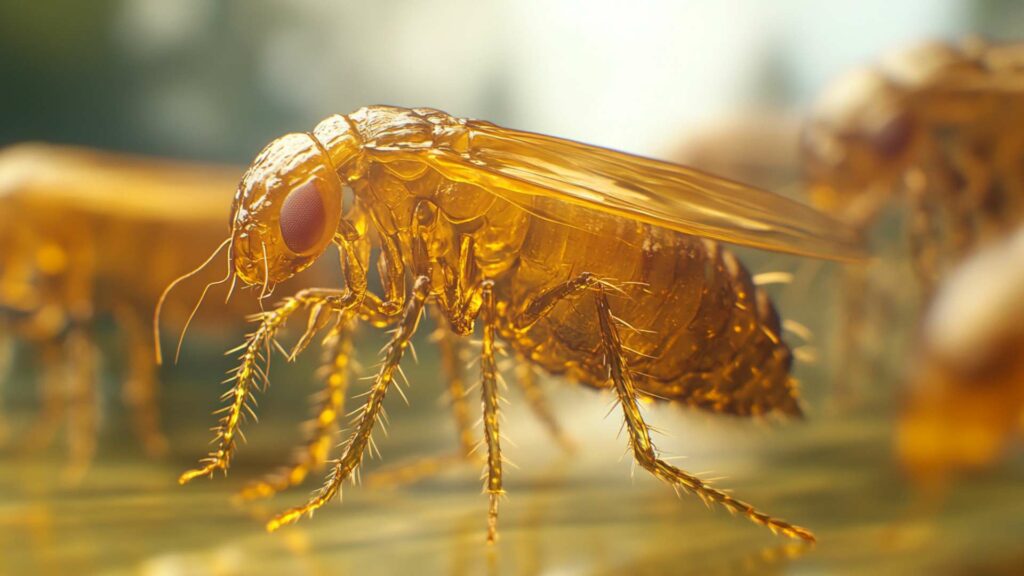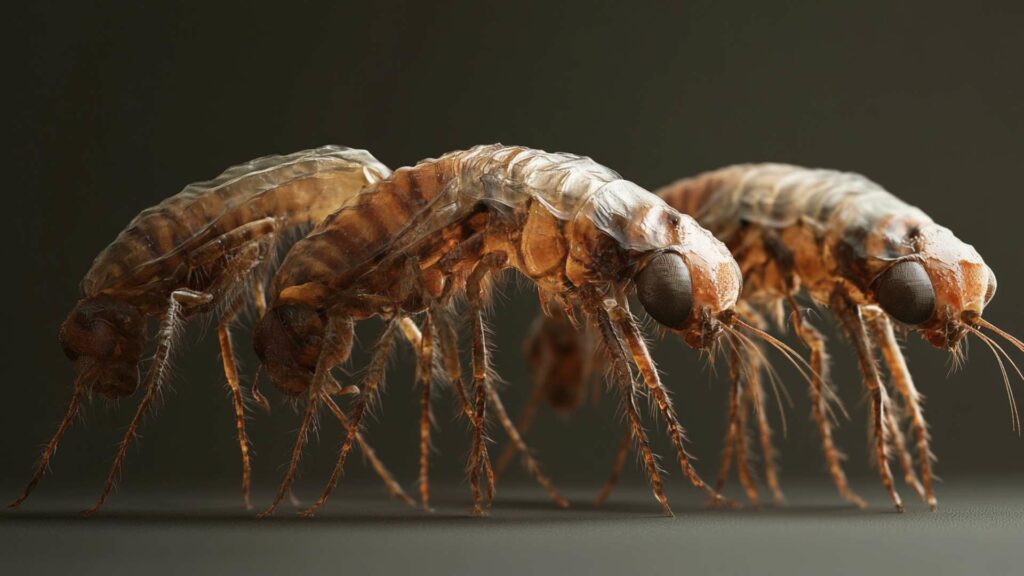Flea allergies, also known as flea allergy dermatitis (FAD), are common among our furry friends. These allergies occur when a pet has an immediate hypersensitivity to the saliva of fleas. When a flea bites an allergic pet, the flea saliva often triggers an immune response, causing intense itching and discomfort.
This allergic reaction can lead to various clinical signs, such as redness, swelling, hair loss, and even secondary skin infections like yeast infections.
Importance of Prevention for Pet’s Well-Being:

As responsible pet owners, it is crucial for us to understand that prevention plays a vital role in maintaining our pets’ well-being.
Just a few flea bites can cause immense discomfort for our beloved companions. Dogs with flea collars and cats suffering from flea allergy dermatitis experience constant itching and scratching that often leads to painful skin lesions.
Moreover, repeated exposure to fleas can worsen the allergic reaction over time. By implementing effective prevention strategies, we can spare our pets from the misery of developing flea and allergy dermatitis in dogs alone.
Flea allergies not only affect our pets’ physical health but also their mental well-being. Constant itching caused by flea infestation can leave them feeling restless and agitated.
They may exhibit behavioral changes such as excessive grooming or becoming irritable due to the discomfort they experience from fleas and their bites. To ensure our furry friends live comfortable and happy lives free from the distressing effects of fleas, let’s explore some valuable tips on how we can prevent flea allergies in pets effectively.
Understanding Fleas and Their Behavior
Overview of the Flea Life Cycle
To effectively prevent fleas from wreaking havoc on our beloved pets, it’s crucial to understand the fascinating life cycle of these tiny but mighty pests. The flea life cycle encompasses four main stages: egg, larva, pupa, and adult.
It all begins with a female flea laying her eggs on your pet’s skin. These eggs are minuscule and tend to fall off into your pet’s environment, whether it’s your living room carpet or their cozy bed.
Within a few days, these eggs hatch into larvae that resemble tiny worms. Larvae are quite mobile and will actively avoid bright light by seeking shelter in dark corners or deep within carpets.
As they grow, larvae feed on various organic matter such as flea feces (yes, you read that right!), dead skin cells, and other debris found in their surroundings. After a period of about one to two weeks, the larvae spin cocoons and enter their pupal stage.
This phase can last anywhere from several days to several months depending on environmental conditions such as temperature and humidity. Adult fleas emerge from their pupae when conditions are favorable.
Triggered by vibrations or increased carbon dioxide levels (think movement or potential hosts nearby), adult fleas jump onto our unsuspecting pets for a nourishing blood meal required for reproduction. And so the cycle continues unless we intervene with effective flea prevention measures.
Common Areas Where Fleas Thrive
Fleas are resourceful little parasites that can infest not only our furry friends but also various spaces within our homes and outdoor environments. Understanding where these critters tend to flourish is key to preventing their unwelcome presence. Within households, carpets act as prime real estate for fleas due to their warm fibers offering ideal hiding spots for eggs and developing flea stages.
Upholstered furniture, especially those frequented by our pets, can also harbor these pesky intruders. Additionally, neglected areas like cracks in wooden floors, baseboards, and even pet bedding can become havens for fleas to establish themselves.
Outdoor spaces can be equally problematic. Gardens with lush vegetation and moist soil provide an ideal habitat for fleas to thrive.
Fleas may hitch a ride on feral cats domestic dogs or other wildlife that frequent your yard, bringing them closer to your doorstep. Therefore, it becomes crucial to not only protect our pets from fleas outside but also create a barrier that prevents these parasites from invading our homes.
By understanding the flea life cycle and identifying common areas where they thrive, we gain valuable knowledge in combating these persistent pests effectively. Armed with this knowledge, we can now explore the best methods for flea prevention in the subsequent sections of this article.
Effective Flea Prevention Methods
Regular Grooming Practices for Pets

When it comes to keeping those pesky fleas at bay, regular grooming practices for your furry friends play a crucial role. Brushing and combing your pets not only helps them maintain a shiny coat but also aids in the prevention of fleas and eggs.
By using a fine-toothed flea comb, you can efficiently remove these irritating parasites from your pet’s fur. During the grooming process, pay extra attention to areas where fleas tend to hide, such as behind the ears, under the armpits, and around the tail base.
Comb through their fur gently but thoroughly, making sure to eliminate any adult fleas or eggs that you come across. Remember that adult fleas are agile little critters and can jump away if not caught promptly!
Maintaining a Clean Living Environment

While regular grooming helps prevent fleas on your pets directly, maintaining a clean living environment is equally important in combating these pests effectively. Fleas thrive in carpets, rugs, upholstery, and bedding due to their warm and cozy nature.
To keep these areas flea-free, make vacuuming a regular part of your cleaning routine. Vacuum carpets, rugs, and upholstery at least once or twice a week—paying close attention to areas where your furry friend spends most of their time lounging around.
The powerful suction of the vacuum cleaner will not only suck up adult fleas but also their eggs and larvae hiding within fibers. Additionally, don’t forget about washing pet bedding frequently in hot water.
This simple yet effective step will help eliminate any live fleas or eggs that may be lurking in their favorite resting spots. Opt for hot water settings as heat kills fleas at all life stages.
Utilizing Flea Control Products
In cases where prevention methods alone might not be sufficient, utilizing flea control products can provide an extra layer of defense against these persistent parasites. Two popular options are spot-on treatments and oral medications. Spot-on treatments are applied topically to your pet’s skin, usually between the shoulder blades or at the base of their neck.
These treatments typically contain medication that kills adult fleas and prevents their reproduction by targeting flea eggs and larvae. They are highly effective in controlling fleas for up to a month, providing continuous protection.
Oral medications, on the other hand, offer an alternative approach by delivering flea-preventative medication through ingestion. These medications come in different forms such as tablets or chewables and work by inhibiting fleas’ ability to reproduce or by killing them directly upon biting your pet.
They offer convenience and ease of use while effectively combating most flea infestations too. Remember that when it comes to selecting the right product for your furry friend, it is essential to consider factors such as their weight, age, overall health, and any existing medical conditions they may have.
Consulting with your veterinarian will help you determine the most suitable option for your pet’s specific needs. By incorporating regular grooming practices, maintaining a clean living environment, and utilizing appropriate flea control products like spot-on treatments or oral medications, you can greatly reduce the risk of flea infestations in your home and keep those itchy bites at bay!
Disclaimer: This article is intended for informational purposes only and should not be considered a substitute for professional veterinary advice. If you suspect that your pet is suffering from flea allergy dermatitis or any other common dermatologic disease related to fleas or allergies, consult with a veterinarian for proper diagnosis and treatment options tailored to your pet’s specific condition.
Natural Remedies for Flea Prevention
Essential Oils that Repel Fleas Naturally
When it comes to natural flea prevention, essential oils can be a pet owner’s secret weapon. These potent extracts derived from plants have long been known for their aromatic and pest-repellent properties. Two essential oils that stand out in repelling fleas are lavender oil and lemongrass oil.
Lavender oil not only boasts a delightful scent, but it also possesses soothing properties that can calm irritated skin caused by flea bites. Moreover, fleas find the smell of lavender quite offensive, making it an effective deterrent.
By diluting a few drops of lavender oil with water or carrier oil, you can create a homemade flea spray to apply directly on your pet’s coat or bedding. Similar to lavender oil, lemongrass oil contains compounds that irritate and repel fleas.
Its strong scent is particularly effective in discouraging these pesky pests from taking up residence on your pets or inside your home. You can mix a few drops of lemongrass oil with water in a spray bottle and lightly mist your pet’s environment, including their favorite resting spots.
Homemade Flea Sprays Using Natural Ingredients
In addition to essential oils, there are other natural ingredients found in most kitchens that can help keep fleas at bay. Apple cider vinegar and lemon juice are two such ingredients known for their flea-fighting abilities.
Apple cider vinegar is believed to alter the pH balance of your pet’s skin, making it less appealing for fleas. To create an apple cider vinegar spray, mix equal parts water and apple cider vinegar in a spray bottle.
Gently spritz this solution onto your pet’s coat while avoiding their eyes and any open wounds or irritated skin caused by scratching. Lemon juice is another pantry staple that possesses natural acidity, which is unappealing to fleas.
By combining freshly squeezed lemon juice with water and transferring it to a spray bottle, you can effectively deter fleas from latching onto your pet’s fur. However, it’s important to note that excessive use of lemon juice may cause lightening of your pet’s hair color, so use this natural remedy in moderation.
These homemade flea sprays offer a safer alternative to chemical-based products while providing an additional layer of protection against fleas. While they may not entirely eliminate a single flea bite or infestation, they can be used as part of an integrative approach to controlling these unwanted pests.
Remember that prevention is key when it comes to flea allergy dermatitis and the overall well-being of your furry companions. Implementing these natural remedies alongside regular grooming practices and maintaining a clean living environment will significantly reduce the risk of both live fleas and developing skin infections associated with flea bites.
Additional Tips for Flea Prevention
Regularly Washing Pet Accessories
One often overlooked aspect of flea prevention is the regular washing of pet accessories such as collars, leashes, and toys. These items can accumulate fleas, flea eggs, and flea dirt over time, creating a breeding ground for these pesky parasites.
By regularly washing these accessories in hot water with mild detergent, you can effectively eliminate any potential fleas hiding in them. For collars and leashes that are not machine-washable, consider using a pet-safe disinfectant spray to kill any lingering fleas or eggs.
Keeping Outdoor Areas Clean

To minimize exposure to fleas for your pets, it is crucial to keep your outdoor areas clean and free from debris that may attract them. Fleas thrive in warm and humid environments, so pay special attention to shaded areas around your yard where they might hide. Regularly mow your lawn and trim bushes to reduce the flea population habitat.
Additionally, remove any piles of leaves or debris where adult fleas or their eggs may be lurking. By maintaining a clean outdoor space, you can significantly reduce the risk of when flea infestations occur.
Consulting with a Veterinarian
When it comes to preventing flea allergies and ensuring the well-being of your pets, it is always wise to consult with a veterinarian for personalized advice. Your vet can provide guidance on effective flea control products suitable for your pet’s specific needs. They may recommend oral medications or spot-on treatments containing insect growth regulators that disrupt the flea life cycle.
Moreover, veterinarians can conduct skin tests or intradermal allergy tests to identify if your pets have flea allergies or other underlying skin conditions causing discomfort. If necessary, they may prescribe additional treatments such as antihistamines or medications to address allergic reactions or secondary skin infections resulting from flea bites.
Remember, your veterinarian is an invaluable resource in guiding you towards the best flea prevention methods tailored to your pet’s unique circumstances. By following these additional tips for flea prevention, including regularly washing pet accessories, keeping outdoor areas clean, and seeking professional advice from a veterinarian, you can ensure your pets remain happy, healthy, and free from the unpleasant consequences of flea infestations.
Conclusion
Flea allergy prevention tips are essential for the well-being of our beloved dogs and cats. By understanding the behavior of fleas and implementing effective prevention methods, we can keep our furry friends safe from the misery of flea allergies.
Regular grooming practices such as brushing and combing not only help in removing fleas and their eggs but also provide an opportunity to bond with our pets. Maintaining a clean living environment, including regular vacuuming and washing pet bedding, significantly reduces the chances of fleas infesting our homes.
Utilizing flea control products, such as spot-on treatments or oral medications recommended by veterinarians, plays a crucial role in preventing flea infestations. These flea products target fleas at different stages of their life cycle, ensuring long-lasting protection for our pets.
In addition to conventional methods, natural remedies like essential oils (such as lavender or lemongrass) and homemade sprays (using apple cider vinegar or lemon juice) offer alternative options for repelling fleas naturally. Remember to wash pet accessories regularly and keep outdoor areas clean to minimize exposure to fleas from feral animals.
If your pet is particularly susceptible to flea allergies or has already been diagnosed with flea allergy dermatitis by a veterinary dermatologist, strict flea control is vital. This may involve using special shampoos or medications specifically catered to managing this condition.
With proper prevention techniques in place, we can reduce the risk of secondary skin infections caused by excessive scratching and improve the overall quality of life for our furry companions. While dealing with fleas may seem like a daunting task at times, it is comforting to know that there are numerous effective ways to prevent these pesky parasites from causing havoc in our pets’ lives.
By following these three cats’ flea allergy dermatitis prevention tips diligently and consulting with a veterinarian if needed, we can create a safe environment that minimizes the risk of developing flea allergy dermatitis. So, let’s take the necessary steps to keep our pets happy, healthy, and free from the itchy misery of flea infestations!
Get rid of fleas with D-Termination: The top pest control service in Las Vegas!

If you’re dealing with flea issues on your Las Vegas property, rely on D-Termination for assistance. Our expert team excels in eliminating flea infestations and restoring comfort and peace to your space. Say farewell to fleas—opt for D-Termination for effective pest control today!
Contact us at 702-919-6310 or visit dtermination.com to schedule your flea control service and reclaim your space from these bothersome pests.
Frequently Asked Questions:
Preventing flea allergies involves regular pet grooming, using flea preventatives, and maintaining a clean home environment.
Halting an allergic reaction to flea bites can be achieved with antihistamines, corticosteroid creams, and avoiding further exposure.
The best solution for flea allergy dermatitis often includes prescribed medications such as corticosteroids or antihistamines, as recommended by a veterinarian.
Natural remedies for flea allergies include herbal shampoos, essential oils like lavender or chamomile, and maintaining a flea-free environment.








